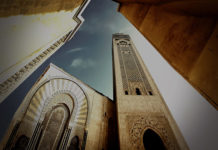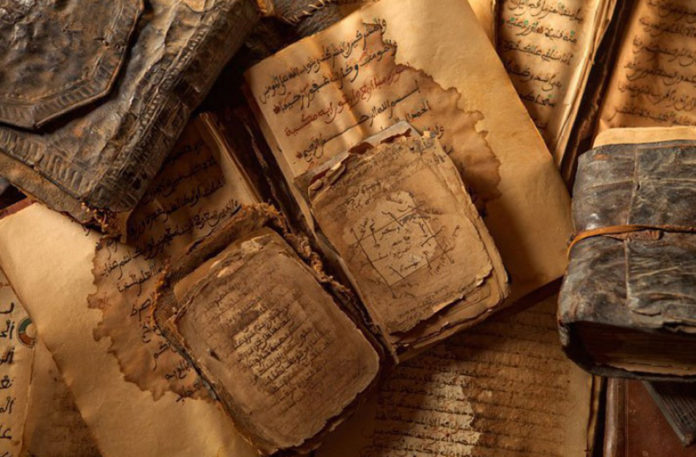Restoration Of The First Mushaf

Mohamed Seif el-Shazli has renovated a lot of manuscripts and monuments in his time. He spent 10 years in the holy city of Mecca restoring old documents and books. But nothing has come close to the importance of his latest project: the restoration of possibly the first mushaf ever written.
EI-Shazli, along with his son Ahmed, has spent the past year diligently rebuilding the leather pages of the 1,400-year-old book. The holy book – which stands a staggering 50 centimeters high – has been kept in the relics room of al-Hussein Mosque for the past 100 years. “This may not be the most difficult project that I have done, but it is a project that feeds my soul,” says el-Shazli, 58, whose grandfather, Shazli Mahmoud Alî, worked during the 1920s with British and American archeologists restoring artifacts found at Giza and Saqqara pyramids.
EI-Shazli learned the craft of restoration from his father, el-Shazli Mahmoud. He began his apprenticeship when he was 12 years old, assisting his father in restoring leather, moldings, weaving, and wood, as well as manuscripts and books. But it wasn’t until he was in his twenties that felt he could work on restoration projects alone.
EI-Shazli, a faculty member in the archeology department at Cairo University, was a natural selection when the Egyptian government was looking for someone to restore the Qur’ân. In addition to his experience in the field, like the ardent scribes of early Islâm, he has memorized the entire Qur’ân.
The restoration project is the brainchild of Dr. Souad Maher, the former dean of Cairo University archeology department, who is renowned for being the first female to attain a doctorate in Islamic history in the Arab world. She has long been involved in the renovations of the relics in the mosque and during the 1960s she verified the authentidty of the relics, using the scientific carbon-testing method to determine that the mushaf (The Qur’ân is the arabic speech of Allâh, which He reveald to Muhammad (salallâhu alayhe wa salam) in wording and meaning, and which has been preserved in the mushafs, and has reached us in mutawâtir transmissions – a mushaf is a written copy of the Qur’ân) dated back to the time of the Prophet Muhammed (salallâhu alayhe wa salam).
Maher restored the same mushaf 45 years ago, but she says that the wear and tear of the years made additional restoration work necessary. She petitioned the Ministry of Awqaf to allocate money for the renovation. “The problem is that many people come to see the book, to touch and kiss it,” says Maher. “This is a very important project. After all, this is (possibly) the first (oldest) mushaf in the world. The inscriptions are perfect.”
The Uthmân mushaf, as it is known, is one of four mushaf hand-written by the third Caliph Uthmân. The Prophet Mohammed’s disciples used to write down his recitations on leaves, animal skins and rocks and kept the writings in the home of Hafsa, one of the Prophet’s widows. Uthmân, the son-in-law of the Prophet collected the Prophet’s writings after his death and put them into one book, creating the version now accepted by Muslims. Uthmân made four copies to be distributed in the Arab world. One was sent to the ruler of Egypt; the other three are believed to be in Iraq, Yemen and Syria.
Uthman is remembered as the Caliph who pushed for the preservation of the Qur’ân,in written form, in one book.
Since that time, the holy book has been in the possession of each successive Egyptian ruler. About 500 years ago, the Uthmân mushaf was moved from the ruler’s home to a place called “relics of the Prophet” in old Cairo, then to Amr Ibn el-Aas Mosque in Old Cairo, then to the Salâh Tala’i Mosque also in old Cairo and finally to al-Hussein building where it has been ever since.
The years however, haven’t been kind to the book. Although it was carefully enclosed in a leather box and a glass case, dust had accumulated between the 1,400 pages and tiny insects had eaten away some portions of the leather pages.
El-Shazli spent the first two months cleaning the pages of the mushaf and sanitizing the book to kill all the insects, before beginning the restoration work. Two kilos of dust had accumulated in the box where the mushaf was kept.
Each page takes roughly two weeks to restore. El-Shazli first stretches the old deerskin page between pieces of glass for a week, then fills in any gaps with chemical-free paper. He hand- paints any holes in the letters, however he refuses to replace any completely-missing letters or words, saying that he doesn’t want to alter the text of the mushaf in any way. “That is the line I don’t want to cross when restoring a manuscript,” he says.
In the sacred room, el-Shazli works slowly and methodically. Wearing glasses similar to a jeweler’s, he studies a portion of the leather page which he has mounted on white paper. As his son Ahmed looks on, he paints in portions where the letters have worn away. After a year and a half of this work, he says the restoration is nearly 80 percent complete. By the summer he says, the mushaf should be completely restored. After that, el-Shazli hopes the book will be put on display, for any interested scholar or tourist to view. “It is part of our heritage,” he says. “It is important that people who want to see it, are able to see the first book in Islâm.”
Sheikh Ahmed is quick to point out that physical age of the book is secondary to the message inside. “This isn’t just a book to be blessed by, it is a way of life,” Sheikh Ahmed says. “The Qur’ân tells us not only how to pray, but how to work, cultivate and beautify life.”

The images above are reproduced from the stated sources under the provisions of the copyright law. This allows for the reproduction of portions of copyrighted material for non-commercial, educational purposes.
With the exception for those images which have passed into the public domain, the use of these images for commercial purposes is expressly prohibited without the consent of the copyright holder.
(NOTE: If you want to build a strong and powerful relationship with Allah, check out Islamia TV, where you can watch Islamic speakers from across the globe deliver inspiring and motivational courses. Learn more at www.islamia.tv.)















































